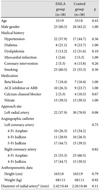1. Jolly SS, Amlani S, Hamon M, Yusuf S, Mehta SR. Radial versus femoral access for coronary angiography or intervention and the impact on major bleeding and ischemic events: a systematic review and meta-analysis of randomized trials. Am Heart J. 2009. 157:132–140.
2. Agostoni P, Biondi-Zoccai GG, de Benedictis ML, et al. Radial versus femoral approach for percutaneous coronary diagnostic and interventional procedures; systematic overview and meta-analysis of randomized trials. J Am Coll Cardiol. 2004. 44:349–356.
3. Goldberg SL, Renslo R, Sinow R, French WJ. Learning curve in the use of the radial artery as vascular access in the performance of percutaneous transluminal coronary angioplasty. Cathet Cardiovasc Diagn. 1998. 44:147–152.
4. Hildick-Smith DJ, Lowe MD, Walsh JT, et al. Coronary angiography from the radial artery: experience, complications and limitations. Int J Cardiol. 1998. 64:231–239.
5. Hildick-Smith DJ, Walsh JT, Lowe MD, Shapiro LM, Petch MC. Transradial coronary angiography in patients with contraindications to the femoral approach: an analysis of 500 cases. Catheter Cardiovasc Interv. 2004. 61:60–66.
6. Kiemeneij F, Vajifdar BU, Eccleshall SC, Laarman G, Slagboom T, van der Wieken R. Evaluation of a spasmolytic cocktail to prevent radial artery spasm during coronary procedures. Catheter Cardiovasc Interv. 2003. 58:281–284.
7. Ruiz-Salmerón RJ, Mora R, Vélez-Gimón M, et al. Radial artery spasm in transradial cardiac catheterization: assessment of factors related to its occurrence, and of its consequences during follow-up. Rev Esp Cardiol. 2005. 58:504–511.
8. He GW, Yang CQ. Characteristics of adrenoceptors in the human radial artery: clinical implications. J Thorac Cardiovasc Surg. 1998. 115:1136–1141.
9. Kim JY, Yoon J, Yoo BS, Lee SH, Choe KH. The effect of a eutectic mixture of local anesthetic cream on wrist pain during transradial coronary procedures. J Invasive Cardiol. 2007. 19:6–9.
10. Todd KH, Funk KG, Funk JP, Bonacci R. Clinical significance of reported changes in pain severity. Ann Emerg Med. 1996. 27:485–489.
11. Imholz BP, Wieling W, van Montfrans GA, Wesseling KH. Fifteen years experience with finger arterial pressure monitoring: assessment of the technology. Cardiovasc Res. 1998. 38:605–616.
12. Guelen I, Westerhof BE, Van Der Sar GL, et al. Finometer, finger pressure measurements with the possibility to reconstruct brachial pressure. Blood Press Monit. 2003. 8:27–30.
13. Bogert LW, van Lieshout JJ. Non-invasive pulsatile arterial pressure and stroke volume changes from the human finger. Exp Physiol. 2005. 90:437–446.
14. Fukuda N, Iwahara S, Harada A, et al. Vasospasms of the radial artery after the transradial approach for coronary angiography and angioplasty. Jpn Heart J. 2004. 45:723–731.
15. Joly LM, Spaulding C, Monchi M, Ali OS, Weber S, Benhamou D. Topical lidocaine-prilocaine cream (EMLA) versus local infiltration anesthesia for radial artery cannulation. Anesth Analg. 1998. 87:403–406.
16. Smith M, Gray BM, Ingram S, Jewkes DA. Double-blind comparison of topical lignocaine-prilocaine cream (EMLA) and lignocaine infiltration for arterial cannulation in adults. Br J Anaesth. 1990. 65:240–242.
17. Hjemdahl P. Plasma catecholamines: analytical challenges and physiological limitations. Baillieres Clin Endocrinol Metab. 1993. 7:307–353.
18. Olday SJ, Walpole R, Wang JY. Radial artery cannulation: topical amethocaine gel versus lidocaine infiltration. Br J Anaesth. 2002. 88:580–582.







 PDF
PDF ePub
ePub Citation
Citation Print
Print






 XML Download
XML Download